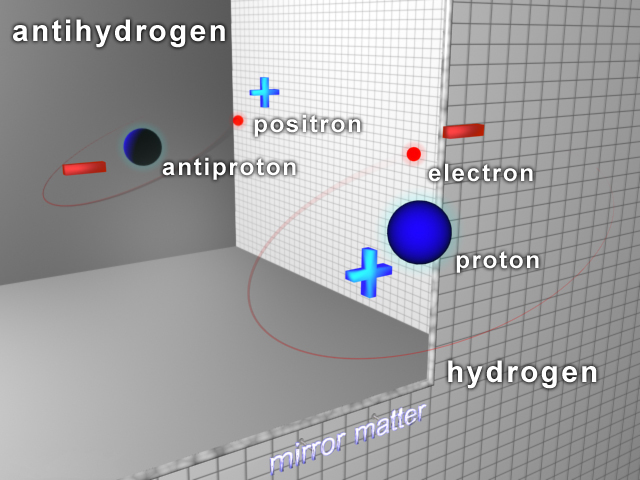|
Antihydrogen
Antihydrogen () is the antimatter counterpart of hydrogen. Whereas the common hydrogen atom is composed of an electron and proton, the antihydrogen atom is made up of a positron and antiproton. Scientists hope that studying antihydrogen may shed light on the question of why there is more matter than antimatter in the observable universe, known as the baryon asymmetry problem. Antihydrogen is produced artificially in particle accelerators. Experimental history Accelerators first detected hot antihydrogen in the 1990s. ATHENA studied cold in 2002. It was first trapped by the Antihydrogen Laser Physics Apparatus (ALPHA Collaboration, ALPHA) team at CERN in 2010, who then measured the structure and other important properties. ALPHA, AEGIS, and GBAR plan to further cool and study atoms. 1s–2s transition measurement In 2016, the ALPHA experiment measured the atomic electron transition between the two lowest energy levels of antihydrogen, 1s–2s. The results, which are identical t ... [...More Info...] [...Related Items...] OR: [Wikipedia] [Google] [Baidu] |
Antimatter
In modern physics, antimatter is defined as matter composed of the antiparticles (or "partners") of the corresponding particles in "ordinary" matter. Antimatter occurs in natural processes like cosmic ray collisions and some types of radioactive decay, but only a tiny fraction of these have successfully been bound together in experiments to form antiatoms. Minuscule numbers of antiparticles can be generated at particle accelerators; however, total artificial production has been only a few nanograms. No macroscopic amount of antimatter has ever been assembled due to the extreme cost and difficulty of production and handling. Theoretically, a particle and its antiparticle (for example, a proton and an antiproton) have the same mass, but opposite electric charge, and other differences in quantum numbers. A collision between any particle and its anti-particle partner leads to their mutual annihilation, giving rise to various proportions of intense photons (gamma rays), neutrin ... [...More Info...] [...Related Items...] OR: [Wikipedia] [Google] [Baidu] |
Antiproton Decelerator
The Antiproton Decelerator (AD) is a storage ring at the CERN laboratory near Geneva. It was built from the Antiproton Collector (AC) to be a successor to the Low Energy Antiproton Ring (LEAR) and started operation in the year 2000. Antiprotons are created by impinging a proton beam from the Proton Synchrotron on a metal target. The AD decelerates the resultant antiprotons to an energy of 5.3 MeV, which are then ejected to one of several connected experiments. The major goals of experiments at AD are to spectroscopically observe the antihydrogen and to study the effects of gravity on antimatter. Though each experiment at AD has varied aims ranging from testing antimatter for cancer therapy to CPT symmetry and antigravity research. History From 1982 to 1996, CERN operated the Low Energy Antiproton Ring (LEAR), through which several experiments with slow-moving antiprotons were carried out. During the end stages of LEAR, the physics community involved in those antimatter ex ... [...More Info...] [...Related Items...] OR: [Wikipedia] [Google] [Baidu] |
ALPHA Collaboration
The Antiproton Decelerator (AD) is a storage ring at the CERN laboratory near Geneva. It was built from the Antiproton Collector (AC) to be a successor to the Low Energy Antiproton Ring The Low Energy Anti-Proton Ring (LEAR) was a particle accelerator at CERN which operated from 1982 until 1996. The ring was designed to decelerate and store antiprotons, to study the properties of antimatter and to create atoms of antihydrogen. ... (LEAR) and started operation in the year 2000. Antiprotons are created by impinging a proton beam from the Proton Synchrotron on a metal target. The AD decelerates the resultant antiprotons to an energy of 5.3 MeV, which are then ejected to one of several connected experiments. The major goals of experiments at AD are to Spectroscopy, spectroscopically observe the antihydrogen and to study the effects of gravity on antimatter. Though each experiment at AD has varied aims ranging from testing antimatter for cancer therapy to CPT symmetry and Anti-gr ... [...More Info...] [...Related Items...] OR: [Wikipedia] [Google] [Baidu] |


_Hall.jpg)